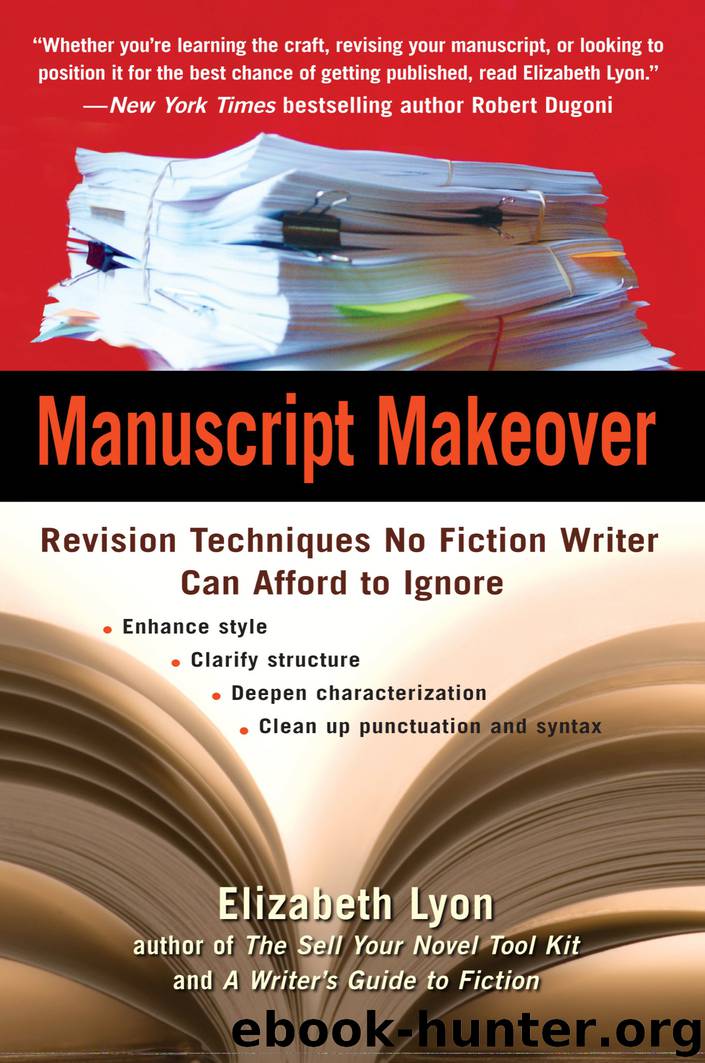Manuscript Makeover by Elizabeth Lyon

Author:Elizabeth Lyon
Language: eng
Format: epub
Publisher: Penguin Publishing Group
Published: 2010-02-28T16:00:00+00:00
For Different Character Viewpoints
With fewer cardinal rules against using present and past tense, and first- and third-person in one novel, writers have more creative freedom to experiment. Like all experiments, some work and some don’t—and the success is a subjective judgment. The most common mixture is the use of first person for the protagonist’s viewpoint and third person for all other characters’ viewpoints. Sometimes, present tense accompanies first person and past tense accompanies third person. In this way, the protagonist is the peacock with the most brilliance, intensity, and immediacy of story. Seldom, but it’s an interesting choice, first person, past tense is used for the protagonist and third person, present tense is used for other characters. The question: Do your choices work well? Are they the best for your novel?
In the following examples from Animal Dreams, Barbara Kingsolver has chosen the latter: protagonist—first person, past tense; father—third person, present tense:
Protagonist: I dragged my bags to the edge of the street. Carlo, my lover of ten years, whom I seemed to have just left, would be sending a trunk from Tucson when he got around to it. I didn’t own very much I cared about.
Father: For a long time he stands gripping the door frame, which is exactly the width of a newborn’s skull and curves similarly against his palm. He watches his daughters, though there’s nothing to watch....
A particularly risky and creative mixture of viewpoints and tense appears in one children’s book for ages nine to twelve. In Crooked River, author Shelley Pearsall chose first person, past tense for Rebecca, her protagonist, and first person, present tense for her only other character viewpoint, a captured Chippewa Indian. Two first-person viewpoints! In Crooked River, Pearsall met the challenge of creating an authentic voice for the thirteen-year-old settler girl, the young Chippewa, and the year 1812. The excerpt that follows is in the first-person, past-tense viewpoint of Rebecca:
I saw Augustus Root stand up and move toward my Pa. He was a lawyer from the East who had been living in our settlement for nearly two years. But I must confess, me and Laura never took much of a liking to him. Mr. Root seemed to think more highly of himself than a person should and was terribly fond of listening to the sound of his own voice.
He was also the only man we knew who still dressed in knee breeches and stockings. And truth to speak, Mr. Root’s legs were nothing to look at neither. Scrawny old bird legs in white stockings. . . .
And here is the first-person, present-tense viewpoint of Indian John. His viewpoint appears in two- or three-page sections, in italics, at the end of nearly every chapter. Formatted more like stanzas in a poem, the lowercase letters that begin lines are intentional:
when I hear the name Semo,
i laugh
inside my mouth.
Download
This site does not store any files on its server. We only index and link to content provided by other sites. Please contact the content providers to delete copyright contents if any and email us, we'll remove relevant links or contents immediately.
| Publishing & Books | Research |
| Writing |
Asking the Right Questions: A Guide to Critical Thinking by M. Neil Browne & Stuart M. Keeley(5705)
Autoboyography by Christina Lauren(5202)
Eat That Frog! by Brian Tracy(4479)
Dialogue by Robert McKee(4352)
Sticky Fingers by Joe Hagan(4142)
Journeys Out of the Body by Robert Monroe(3588)
Annapurna by Maurice Herzog(3445)
Full Circle by Michael Palin(3413)
Schaum's Quick Guide to Writing Great Short Stories by Margaret Lucke(3342)
Elements of Style 2017 by Richard De A'Morelli(3323)
The Art of Dramatic Writing: Its Basis in the Creative Interpretation of Human Motives by Egri Lajos(3035)
Atlas Obscura by Joshua Foer(2925)
Why I Write by George Orwell(2911)
The Diviners by Libba Bray(2905)
In Patagonia by Bruce Chatwin(2893)
The Fight by Norman Mailer(2884)
The Mental Game of Writing: How to Overcome Obstacles, Stay Creative and Productive, and Free Your Mind for Success by James Scott Bell(2873)
Venice by Jan Morris(2545)
The Elements of Style by William Strunk and E. B. White(2452)
